Where You Can Park
This section of the Florida Driver Handbook covers parking techniques and laws.
Topics Addressed in this section of the Florida Driver Handbook include:
Parking
When parking on a public road, move as far away from traffic as possible. If there is a roadside shoulder, pull as far onto it as you can. If there is a curb, pull close to it — you must not park more than one foot away.
Always park on the right side of the roadway, unless it is a one-way street. Make sure your vehicle cannot move. Set the parking brake and shift to park with an automatic transmission or reverse with a manual transmission. Turn off the engine and lock the vehicle. Florida law requires that you take the keys out of your vehicle before leaving it. Always check traffic behind you before getting out, or get out on the curb side.
Before you leave any parked position, look over your shoulder to the rear to make sure the way is clear. Give the proper turn signal if driving from a curb and yield to other traffic.
Parking on Hills
When parking on hills:
- Turn your wheels so that if your car starts to move by itself it will roll away from traffic or into the curb. Study the diagram provided.
- Set the parking brake.
- Place automatic gear shift in park. Shift manual gears to reverse (downhill) or first (uphill).

Straight-in Parking
The rear markers represent the REAR corners of the parking space. The forward markers represent the approximate CENTER of the parking space. When properly parked, the vehicle should be centered inside the space with no part of the vehicle extending out into the traffic lane.
Where Parking is not Allowed

- On the roadway side of another parked vehicle (double parking).
- On crosswalks.
- On sidewalks.
- In front of driveways.
- By curbs painted yellow or where "No Parking" signs are posted.
- Within intersections.
- Within 15 feet of a fire hydrant.
- Within 20 feet of an intersection.
- Within 20 feet of the entrance to a fire, ambulance or rescue squad station.
- Within 50 feet of a railroad crossing.
- On the hard surface of a highway where parking spaces are not marked.
- On any bridge or overpass or in any tunnel.
- Within 30 feet of a rural mail box on a state highway between 8 a.m. and 6 p.m.
- Within 30 feet of any flashing signal, stop sign or traffic signal.
- In such a way that you block or create a hazard for other vehicles.
Parking Lights
Parking lights must be used at night on any vehicle parked on a roadway or shoulder outside of cities and towns. vehicle should be centered inside the space with no part of the vehicle extending out into the traffic lane.Driving with parking lights only (in place of headlights) is against the law.
Parking Privilege for Disabled
Disabled persons do not have to pay parking fees on any public street, highway, or metered space. Their vehicles must display a valid parking placard which is visible from the front and rear of the vehicle. Each side of the placard must have the international symbol of accessibility in a contrasting color in the center. These may be obtained from a tag agent or tax collector's office and must be renewed every four years.
Disabled persons must park in spaces reserved for the disabled when possible. These spaces are marked by the wheelchair symbol and "Parking by Disabled Permit Only" signs. Vehicles illegally parked in spaces reserved for the handicapped will be ticketed and may be towed.

- Proof of Eligibility: Statement from a physician licensed in the United States, the Division of Blind Services of the Department of Education, or the Veterans Administration, that the applicant is a severely physically disabled individual with permanent mobility problems which substantially impair his or her ability to ambulate or is certified as legally blind.
- Display: Visible from the front and rear of the vehicle.
- Procedure: Contact your local county tax collector or tag agent.
- Complete HSMV 83039 — Application for a disabled person's parking permit.
- Provide proof of eligibility — Doctor's Statement
- Pay $1.50
- Pay $15.00 for temporary disabled person parking permit.
- Present valid Florida driver license or identification card.
Making Turns
Turning a corner may seem to be a simple operation, but many traffic crashes are caused by drivers who do not turn correctly.
There are nine steps in making a good turn:
- Make up your mind about your turn before you get to the turning point. Turn signals are required when changing lanes. Never make "last minute" turns.
- If you must change lanes, look behind and to both sides to see where other vehicles are located before making your turn.
- Move into the correct lane as you near the intersection. The correct lane for the right turn is the lane next to the right edge of the roadway. On a two-lane road with traffic in both directions, an approach for a left turn should be made in the part of the right half of the roadway nearest the center line.
- Give a turn signal for at least the last 100 feet before you make your turn. Let other drivers know what you are going to do.
- Slow down to a safe turning speed.
- When you are slowing to make a right turn, the bicyclist you passed may be catching up to you. Search over your shoulder before turning. Yield to bicyclists and pedestrians.
- Yield to pedestrians who may be crossing your path when turning left. Always scan for pedestrians before starting the turn.
- Make the turn, staying in the proper lane. Yield the right-of-way to vehicles (including bicycles) coming from the opposite direction.
- Finish your turn in the proper lane. A right turn should be from the right lane into the right lane of the roadway entered. A left turn may be completed in any lane lawfully available, or safe, for the desired direction of travel. See the diagrams for making left turns from or into one-way streets.
If you reach an intersection where you wish to make a right or left turn and are not in the proper lane, you should drive to the next intersection. Then make the turn from the proper lane.
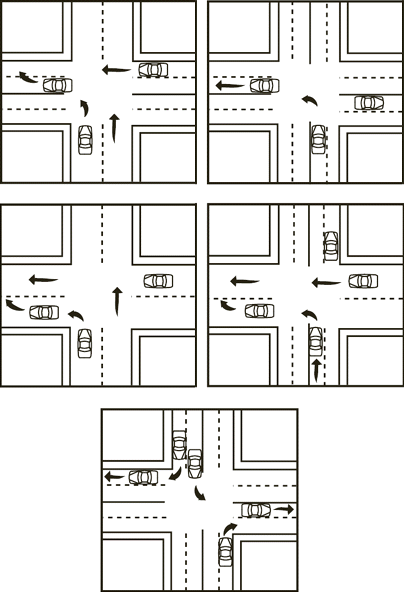
Bike Lanes at Intersections
Slow down and look for bicyclists. Signal your turn prior to crossing through the bike lane at the dashed striping. Yield to any bicyclist. Complete the turn from the designated right turn lane. If there is no right turn lane, after first checking to make sure that no bicyclists are present, you may enter the bike lane at the intersection or driveway.
Turnabout (Three-Point Turn)
Sometimes you will need to turn your car around in a very small space. Use a three-point turn only if the road is too narrow for a U-turn and you can't go around the block. To make a three-point turn:
- Move as far right as possible, check traffic, and signal a left turn.
- Turn the steering wheel sharply to the left and move forward slowly. Stop at the curb, or edge of roadway.
- Shift to reverse, turn your wheels sharply to the right, check traffic, and back your vehicle to the right curb, or edge of roadway.
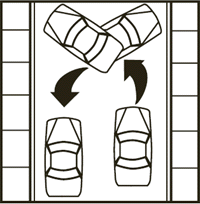
You can now move in the opposite direction. Check the traffic and move forward. Never make a three-point turn or a U-turn on a curve, a hill or when a sign indicates that making a U-turn is prohibited.
Turn Signals and Emergency Signals
You must use hand signals or directional signals to show that you are about to turn. Turn signals are required when changing lanes or overtaking a vehicle. It is against the law to use your directional signals to tell drivers behind you that they can pass. Four-way emergency flashers should only be used while your vehicle is legally stopped or disabled on the highway or shoulder.
Right Turn — Hand Signal

Slow Down — Hand Signal
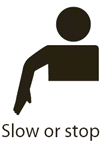
Left Turn — Hand Signal
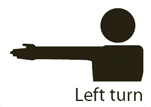
Traffic Lanes
Always drive on the right side of a two-lane highway except when passing. If the road has four or more lanes with two-way traffic, drive in the right lanes except when overtaking and passing.
Left lanes on some interstate roads are reserved for car pool vehicles with two or more occupants in the car — watch for diamond signs in the median. The center lane of a three-lane or five-lane highway is used only for turning left.
If you see red reflectors facing you on the lane lines, you are on the wrong side of the road. Get into the proper lane immediately! If you see red reflectors on the lines on the edge of the road, you are on the wrong freeway ramp. Pull over immediately! Red reflectors always mean you are facing traffic the wrong way and could have a head-on collision.
Blind Spot
Blind spots are areas near the left and right rear corners of your vehicle that you cannot see in your rearview mirrors. Before you move sideways to change lanes on an expressway or to pass on any road, turn your head to make sure these areas are clear. Areas bordered by Xs are blind spots for a car with an outside mirror on the left side only.
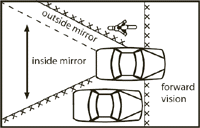
On the roads with more than one lane in each direction, do not drive in someone else's blind spot. Speed up or drop back so the other driver can see you.
Handling Emergencies
When you are driving, things can happen very quickly. You may have only a fraction of a second to make the right move. Follow these guidelines for handling emergencies.
Breakdowns
- If possible, park where the disabled vehicle can be seen for 200 feet in each direction.
- Move the vehicle so all four wheels are off the pavement.
- Turn on your emergency flashers.
- Get all passengers out on the side away from traffic.
- Tie a white cloth on the left door handle or antenna.
- Raise the hood.
Tire Blowout
- Do not use brakes.
- Concentrate on steering.
- Slow down gradually.
- Brake softly when the car is under control.
- Pull completely off the pavement.
Wet Brakes
- Test brakes lightly after driving through deep water.
- Brakes may pull to one side or may not hold at all.
- Dry brakes by driving slowly in low gear and applying brakes.
Right Wheels off Pavement
- Take your foot off the gas pedal.
- Hold the wheel firmly and steer in a straight line.
- Brake lightly.
- Wait until the road is clear.
- Turn back on the pavement sharply at slow speed.
Car or Motorcycle Approaching in your Lane
- Sound your horn.
- Brake sharply.
- Steer for the side of the road or the ditch.
Jammed Gas Pedal
- Keep your eyes on the road.
- Tap the gas pedal with your foot.
- Try to pry the pedal up with the toe of your shoe.
- Shift into neutral.
- Turn off the ignition. (Do not turn the key to lock, or your steering will lock.)
- Use your brakes.
Brake Failure
- Pump the brake pedal hard and fast, except for vehicles with anti-lock brakes.
- Shift to a lower gear.
- Apply the parking brake slowly and make sure that you are holding down the release lever or button. This will prevent your rear wheels from locking and your vehicle from skidding.
- Rub your tires on the curb to slow your vehicle, or pull off the road into an open space.
Skidding
- Take your foot off the gas pedal.
- Do not use your brakes, if possible.
- Pump the brakes gently if you are about to hit something.
- Steer the car into the direction of the skid to straighten the vehicle out. Then steer in the direction you wish to go.
Fire
- If the fire is small and you have a portable extinguisher, you should attempt to extinguish the fire.
- If you cannot extinguish the fire and it continues to get larger, get away from the vehicle, due to the presence of toxic fumes and the possibility of explosion.
- Never apply water to a gasoline or diesel fire.
Animals
When an animal is seen in the road or on the road shoulder, you should slow down and, if necessary, yield the right-of-way. Be especially careful in rural areas at night. Often an animal's eyes shining in the headlight beams will be seen first.
Use reasonable care when approaching a person who is riding or leading an animal on the roadway or shoulder of the road. Horses have poor side vision and are easily frightened by loud noises or sudden movements.
Fog or Smoke
It is best not to drive in fog or smoke. If you must, slow down, turn on your low beam headlights, and be ready for a fast stop. Use windshield wipers in heavy fog. If the fog or smoke becomes so thick that you cannot see well enough to keep driving, pull all the way off the pavement and stop. Turn on your emergency flashers.
Rain
The first few drops of rain mean danger. Roads are most slippery just after the rain begins because oil dropped from cars has not been washed away. Slow down and plan for at least two times the normal stopping distance.
In a heavy rain, your tires can ride on a thin film of water, like skis. This is called hydroplaning. When your tires are not touching the road, you can easily lose control and skid. Keep your tires on the road by slowing down when it rains, and by having tires with the right air pressure and good tread.
Brakes often become wet after driving through deep water or driving in heavy rain. They may pull to one side or the other, or they may not hold at all. If this happens, slow down and gently push on the brake pedal until your brakes are working again.
Reduced Visibility
You must turn on your low beam (dim) headlights when driving between sunset and sunrise, including the twilight hours between sunset and sunrise or between full night and sunrise. You must also use these lights during any rain, smoke or fog. Parking lights do not meet requirements of this law.